
(Photo take by Fraser)
The Set up
When my brother was in PLP he enjoyed every trip he went on. He would tell me about the cool and exciting stuff he did and learned about. This is the original reason about why i wanted to go to loon lake i knew i would regret it if i missed out on this trip and i was right this trip was definitely worth it. As with most worthwhile learning, going into something with a growth mindset makes all the difference.
My Usual Pre-Trip Freakout
As soon as Loon Lake was announced there were three things I was worrying about:
- Most of my friends were not able to come.
- I knew I would have a hard time listening and focusing for the leadership presentations.
- I was very anxious about having enough time to do the homework that I expected would be assigned. I would not have access to LAC or my usual supports.
These concerns while still important did not turn out to be as much a problem as I originally feared. I also made the conscious choice to talk to my teachers before hand about the work load which really helped.
My Personal Growth Journey
On day one Jono had us write down multiple goals/intentions that we wanted to accomplish this week along with a quote. I wrote down the following:
I want to be open to learning and experiencing new things.
I want to build off skills I already have.
I want to have fun and connect with classmates.
I also wrote down how I would achieve this: participating in activities, having a positive attitude and being open minded. The quote I chose to represent my week was by Don Ward who said “your mind can focus on fear, worry, problems, negativity, or despair. Or it can focus on confidence, opportunity, solution, optimism and success. You decide.” I decided to embrace the whole experience.
One of the first experiences that I am especially proud of is the rock wall that we did on day two. I was first up to climb the rock wall and I chose the left side in order to try something new but without too much risk. I finished it easily and thinking about my goal, decided to try the other side. That wall was much harder. I could not climb the wall with gloves on so my fingers quickly froze. I got stuck on a low point on the wall. Over the course of the activity lots of my peers got stuck there and asked to come down or eventually made it to the top. I am proud of myself because I did not ask to come down and I never said that I could not do it. I kept trying even though I was stuck for 20 minutes or so. Once I got past that part, I made it to the top fairly quickly. I knew that I could accomplish the wall and I promised myself that I would try everything!
I had heard small mentions of us doing a really tall trust fall activity on the last day of the leadership program. Because of those hints, I was very anxious when my group was told they were going to do a trust exercise. We started off with a willow in the wind activity where one person stands in the middle of a circle of people, leans back and then gets pushed around the circle by those forming the circle. Then we did personal trust falls, starting with only falling back a few inches to eventually falling back 45 degrees into the waiting arms of three people. I had a hard time doing all those things because I’ve never trusted someone to stop me from falling. Accidentally or otherwise. Then we were taken outside to where a chair was on top of a table. The speaker told us that we would now be doing a trust fall from that height. My first thought was no, no way, not in a million years. I watched four people stand on the chair, say their intention and fall back into the arms of 8 or 9 classmates. I knew that all the kinks had been worked out and that I knew I would regret it if I didn’t do it, so I volunteered to go next. You will see in the video below me saying my intention and then double checking twice with the catchers to see that they were ready. I actually ended up doing it twice, as we were given the option for another. My intention earlier that day was to push myself out of my comfort zone and I believe I did that with this activity.
 The next activity that I showed a lot of growth was on the high ropes course. Someone went first and then I volunteered to follow. Once I climbed up the pole to the platform I pulled my torque over my eyes as a blindfold. The ropes course was considerably harder than I expected it to be but I kept the blindfold and with the help of my friends I made it to the end.
The next activity that I showed a lot of growth was on the high ropes course. Someone went first and then I volunteered to follow. Once I climbed up the pole to the platform I pulled my torque over my eyes as a blindfold. The ropes course was considerably harder than I expected it to be but I kept the blindfold and with the help of my friends I made it to the end.  The other part of the high ropes course was called the milk crates challenge. Two people on harnesses had to be on top of as many milk crates as they could pile. The challenge was to get more than the other groups. While only the two people stood on top of the crates the other team members were on the ground add to the structure. Even though I enjoyed being one of the people in the harness I found I showed more leadership when I was on the ground assisting. Ben T and Dillon were the people in the harnesses and myself and my team helped build the structure 12 milk crates high. Even though we didn’t break the class record of 15, I am still really proud of what we did.
The other part of the high ropes course was called the milk crates challenge. Two people on harnesses had to be on top of as many milk crates as they could pile. The challenge was to get more than the other groups. While only the two people stood on top of the crates the other team members were on the ground add to the structure. Even though I enjoyed being one of the people in the harness I found I showed more leadership when I was on the ground assisting. Ben T and Dillon were the people in the harnesses and myself and my team helped build the structure 12 milk crates high. Even though we didn’t break the class record of 15, I am still really proud of what we did.
Personal Credo
For a couple hours every day John-oh talked to us about emotional intelligence, leadership, strength and values. Then from the information we collected there we were told to create a personal credo. This credo would communicate your values and who you are as your best self and be revised every few months. Twice we gave feedback to anybody who had completed theirs which I found really helpful in finalizing mine. I chose to focus mine on my three main values; family, faith and trust. Once I had written my credo I turned it into a wall paper which you can see below.
Using this credo we all created personal logos that would eventually be printed out and made into stickers for our IPads. In mine I represented faith with the main subject being a dove. I represented trust with hand-shaking and family with a people-filled heart.
Taking what I learned about intentions and setting goals I created 6 SMART goals 3 for this semester and three for this school year. The main academic goals I want to accomplish are:
- Get three extending in humanities projects this semester ( so far I have achieved two)
- Raise my grade for humanities (all year goal)
- Study not just the morning before tests (all year goal)
My more personal ones were:
- Try snowboarding: get good enough to go down hill with my family and not fall to far behind (this semester goal) by end of winter break
- Be able to wake surfing behind a non wake surfing boat like my dads without a rope (right now I can only do it on my uncles boat) I want to do this before the school year ends
- Learn people in my non PLP classes names ( I have always had trouble with names and I want to improve) I want to work on this all year
I then took these SMART goals and added them to my things apps as different projects that I would be able to write steps in order to achieve them. I am planning on checking them off before the end of the school year.
In the end I accomplished all the goals I had written on the first day. I want to be open to learning and experiencing new things. I showed my growth with this goal in the rock climbing and trust falls. I want to build off skills I already have. That one I used with the milk crates and high ropes course. I want to have fun and connect with classmates. Which I did in the activities, playing cards, and taking photos of them and our experiences that you can see at the bottom.
I learned a lot about myself throughout Loon Lake. I learned about making (and most importantly following through) on goals and intentions that I make myself. I learn how I can work better with a team, and how I can be more confident in myself. I will take this information, my credo, and my logo and use it to complete my SMART goals and other intentions I will make myself in the coming months.
Below here are photos I took during this trip.




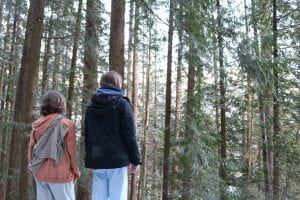

 once they lived here in BC. From a variety of resources we created a chapter card. This character could be based on a real migrant’s story or it could be a fictional character but still based on historical information. At the time I chose Hawaiians for my research topic not knowing it was one of the hardest topics to research. While very interesting, there were limited resources to create a historical fiction story. My character, ‘Iolona, migrated from Hawaii to work with the HBC, then he moved to BC because he would have more civil rights here, and then he joined the gold rush. It was very interesting that the Hawaiians were not given rights in Oregon, but in BC they were treated like “white people”. Other migrants were not treated like that at all. Overall I had to gain more independent research skills to find the information on the Hawaiians and then communicate that information in an interesting way in a character card.
once they lived here in BC. From a variety of resources we created a chapter card. This character could be based on a real migrant’s story or it could be a fictional character but still based on historical information. At the time I chose Hawaiians for my research topic not knowing it was one of the hardest topics to research. While very interesting, there were limited resources to create a historical fiction story. My character, ‘Iolona, migrated from Hawaii to work with the HBC, then he moved to BC because he would have more civil rights here, and then he joined the gold rush. It was very interesting that the Hawaiians were not given rights in Oregon, but in BC they were treated like “white people”. Other migrants were not treated like that at all. Overall I had to gain more independent research skills to find the information on the Hawaiians and then communicate that information in an interesting way in a character card. Our last and final keystone was all about writing a short story based off the character we invented in Keystone 2. We learned about the three act story structure and filled in multiple templates. For the short story we had to consider our audience, make sure our story was historically correct, and craft an interesting story. After creating our first draft, those of us who were done, (6 out of 18) read two stories and gave peer critique on how to improve it for the final draft. I really enjoyed seeing the variety of stories. One of the critiques on my story was on how there wasn’t a conflict in my story. In my story, there WAS both an external conflict and an internal conflict. ‘Iolana lost his equipment in a storm and was debating whether of not to go home for the whole story. BUT the peer feedback made me revise my story so that these conflicts were more obvious. Overall I could have used more time to write my story, but I am proud of what I have written.
Our last and final keystone was all about writing a short story based off the character we invented in Keystone 2. We learned about the three act story structure and filled in multiple templates. For the short story we had to consider our audience, make sure our story was historically correct, and craft an interesting story. After creating our first draft, those of us who were done, (6 out of 18) read two stories and gave peer critique on how to improve it for the final draft. I really enjoyed seeing the variety of stories. One of the critiques on my story was on how there wasn’t a conflict in my story. In my story, there WAS both an external conflict and an internal conflict. ‘Iolana lost his equipment in a storm and was debating whether of not to go home for the whole story. BUT the peer feedback made me revise my story so that these conflicts were more obvious. Overall I could have used more time to write my story, but I am proud of what I have written.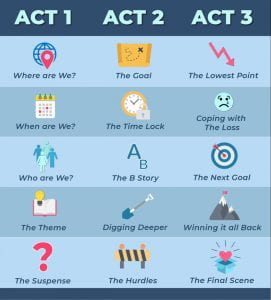
 This last Thursday was the PLP spring exhibition, “💥Impact!”, where we as PLP learners showed our work from throughout the last year to our family and community members. I was put in a group of 9 grade 9’s and we were tasked with the annex AKA the technology room. Our question that drove our room “How do we use technology to deepen our learning?” After several different drafts and a lot of revisions we decided that this is our answer
This last Thursday was the PLP spring exhibition, “💥Impact!”, where we as PLP learners showed our work from throughout the last year to our family and community members. I was put in a group of 9 grade 9’s and we were tasked with the annex AKA the technology room. Our question that drove our room “How do we use technology to deepen our learning?” After several different drafts and a lot of revisions we decided that this is our answer
 Now it was time for us to come up with a room layout. In the drawing we had to include where everyone was standing including all the grade 9 and all 10 of the grade 8 that were showing there work in our room as well. This took many different drafts and tested my teamwork and patience skills, but in the end we created a detailed map.
Now it was time for us to come up with a room layout. In the drawing we had to include where everyone was standing including all the grade 9 and all 10 of the grade 8 that were showing there work in our room as well. This took many different drafts and tested my teamwork and patience skills, but in the end we created a detailed map. The first milestone was to choose a product or service to sell. I handed in three options of something I was interested in selling: cookies, bracelets and babysitting. Out of the three choices, I decided to babysit. I then created a spreadsheet that showed my expenses, time, start-up costs and effect on the environment for one five-hour babysitting job.
The first milestone was to choose a product or service to sell. I handed in three options of something I was interested in selling: cookies, bracelets and babysitting. Out of the three choices, I decided to babysit. I then created a spreadsheet that showed my expenses, time, start-up costs and effect on the environment for one five-hour babysitting job. Using the spreadsheet and the knowledge I gained through the workbooks, I created a linear equation that would predict my earnings for any amount of time. Using that equation, I was able to use the Desmos website to graph my earnings for not only the next year but also how much I would make in a day, week, month and in my life. I found out that I would make more if I did a minimum wage job or was a part time teacher.
Using the spreadsheet and the knowledge I gained through the workbooks, I created a linear equation that would predict my earnings for any amount of time. Using that equation, I was able to use the Desmos website to graph my earnings for not only the next year but also how much I would make in a day, week, month and in my life. I found out that I would make more if I did a minimum wage job or was a part time teacher. In my spreadsheet, I accounted for all of the time, materials and equipment, and included that in my overall cost. I also calculated the effect of the environment from the exhaust from the car that I used to get to the babysitting site. I believe I showed an accomplished and detailed documentation showing my understanding of this curricular competency.
In my spreadsheet, I accounted for all of the time, materials and equipment, and included that in my overall cost. I also calculated the effect of the environment from the exhaust from the car that I used to get to the babysitting site. I believe I showed an accomplished and detailed documentation showing my understanding of this curricular competency. I believe I showed an understanding of this curricular competency. I made a linear equation that properly determines my profit for various amounts of time. Then using this equation I was able to create seven graphs that showed those earnings over time. In my final video, these graphs were labeled and explained in a logical way.
I believe I showed an understanding of this curricular competency. I made a linear equation that properly determines my profit for various amounts of time. Then using this equation I was able to create seven graphs that showed those earnings over time. In my final video, these graphs were labeled and explained in a logical way. I was able to connect mathematical concepts to a business that is of personal interest to me. I compared my business to a minimum wage job and to my mother’s part time teaching position.
I was able to connect mathematical concepts to a business that is of personal interest to me. I compared my business to a minimum wage job and to my mother’s part time teaching position. I also considered the cost of living and the value of my time, along with the sustainability on the environment to decide whether the job is worth it. In the end, I decided that I would not be able to live in Vancouver with the amount I earned and it would be better to think about another possible career. The only thing I would have done differently is consider different levels of jobs.
I also considered the cost of living and the value of my time, along with the sustainability on the environment to decide whether the job is worth it. In the end, I decided that I would not be able to live in Vancouver with the amount I earned and it would be better to think about another possible career. The only thing I would have done differently is consider different levels of jobs.

 I planned out when our group would meet, how we would meet the deadlines, and made sure I contributed using my strengths. I knew I didn’t want to write the whole script so I built the hydraulics in the mysterious object. When a group member dropped out, I helped to alter our story to adapt.
I planned out when our group would meet, how we would meet the deadlines, and made sure I contributed using my strengths. I knew I didn’t want to write the whole script so I built the hydraulics in the mysterious object. When a group member dropped out, I helped to alter our story to adapt.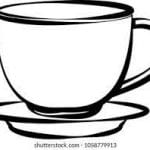 Like a good book, there has been great character development through these projects I mentioned as well as through the the
Like a good book, there has been great character development through these projects I mentioned as well as through the the  The Things app has been really helpful with keeping track of what I have to do and I will continue to use that in Grade 10.
The Things app has been really helpful with keeping track of what I have to do and I will continue to use that in Grade 10.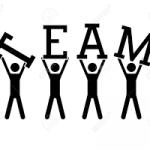 Something else I really wish could be written differently is team work and peer critique. I know the importance of team work but I found my teams this year very challenging. For example, in my last exhibition, my group was full of students who would not contribute or follow through on a plan. Often times, in team work situations others do not follow instructions, which I find disrespectful to the teachers and other learners. Other students tell me not to worry about deadlines and this creates a problem for me that I have not been able to solve yet. Next year, if I were writing the story, I would have more projects where I could pick my partners.
Something else I really wish could be written differently is team work and peer critique. I know the importance of team work but I found my teams this year very challenging. For example, in my last exhibition, my group was full of students who would not contribute or follow through on a plan. Often times, in team work situations others do not follow instructions, which I find disrespectful to the teachers and other learners. Other students tell me not to worry about deadlines and this creates a problem for me that I have not been able to solve yet. Next year, if I were writing the story, I would have more projects where I could pick my partners. Finishing this book, I look forward to the next one in the series. I predict the main character will have many more struggles and problems like deadlines and too many blog posts. But there will also be adventures and growth and hopefully a field school that includes caffeine.
Finishing this book, I look forward to the next one in the series. I predict the main character will have many more struggles and problems like deadlines and too many blog posts. But there will also be adventures and growth and hopefully a field school that includes caffeine.

 Our assignment was to create a 3-5 minute documentary on a topic that is meaningful to us and fulfills all the criteria that our class set out. The first challenge I face was coming up with a topic that was both meaningful to me and would have a message. Out of all of my ideas, my best two were:` social media affecting kids my age and the value of strategy games. In the end, I chose to make my documentary about strategy games because I could personalize it more.
Our assignment was to create a 3-5 minute documentary on a topic that is meaningful to us and fulfills all the criteria that our class set out. The first challenge I face was coming up with a topic that was both meaningful to me and would have a message. Out of all of my ideas, my best two were:` social media affecting kids my age and the value of strategy games. In the end, I chose to make my documentary about strategy games because I could personalize it more. After this step, we wrote a screenplay and story board. I found the screenplay particularly challenging because it was the first time I had to fill in the details of what my documentary was going to look, and sound like. The storyboard was easy because I took what I wrote in the screen play and created a visual representation of what each shot was going to look like.
After this step, we wrote a screenplay and story board. I found the screenplay particularly challenging because it was the first time I had to fill in the details of what my documentary was going to look, and sound like. The storyboard was easy because I took what I wrote in the screen play and created a visual representation of what each shot was going to look like. I was very concerned with how I was going to film everything. I needed shots of people playing specific strategy board and card games. I ended up inviting over my friend and her sisters for a game night after school. My younger sister played games with them while I took shots from different angles. To get the credits video section I played a chess match against Gwen while taking a time-lapse video. In case you were wondering … I won!
I was very concerned with how I was going to film everything. I needed shots of people playing specific strategy board and card games. I ended up inviting over my friend and her sisters for a game night after school. My younger sister played games with them while I took shots from different angles. To get the credits video section I played a chess match against Gwen while taking a time-lapse video. In case you were wondering … I won!

 I showed this competency throughout the project starting with the cloning of the plant. Later we took the root of the plant, followed steps, and made slides we could see under the microscope. On my first three tries, I was not able to get clear photos that showed evidence of Mitosis in the cells. I communicated that problem to Mr. Gross and it seemed I was not the only person who needed better examples so the next class Mr. Gross brought in pre-made slides. With those slides, I took photos and then later identified each stage of mitosis of cells. This data was important for my final product.
I showed this competency throughout the project starting with the cloning of the plant. Later we took the root of the plant, followed steps, and made slides we could see under the microscope. On my first three tries, I was not able to get clear photos that showed evidence of Mitosis in the cells. I communicated that problem to Mr. Gross and it seemed I was not the only person who needed better examples so the next class Mr. Gross brought in pre-made slides. With those slides, I took photos and then later identified each stage of mitosis of cells. This data was important for my final product. The third skill introduced us to planning and shooting. We learned about writing a treatment, a logline, followed by a storyboard. For this skill we created a tutorial which we did as a group using an new iMovie feature. Before we started filming, we created and filled out a storyboard to grow in our planning skills and to make sure we included everything we needed to for the instructions to make sense. My team created a tutorial on how to use a vending machine which in the end turned out quite funny.
The third skill introduced us to planning and shooting. We learned about writing a treatment, a logline, followed by a storyboard. For this skill we created a tutorial which we did as a group using an new iMovie feature. Before we started filming, we created and filled out a storyboard to grow in our planning skills and to make sure we included everything we needed to for the instructions to make sense. My team created a tutorial on how to use a vending machine which in the end turned out quite funny.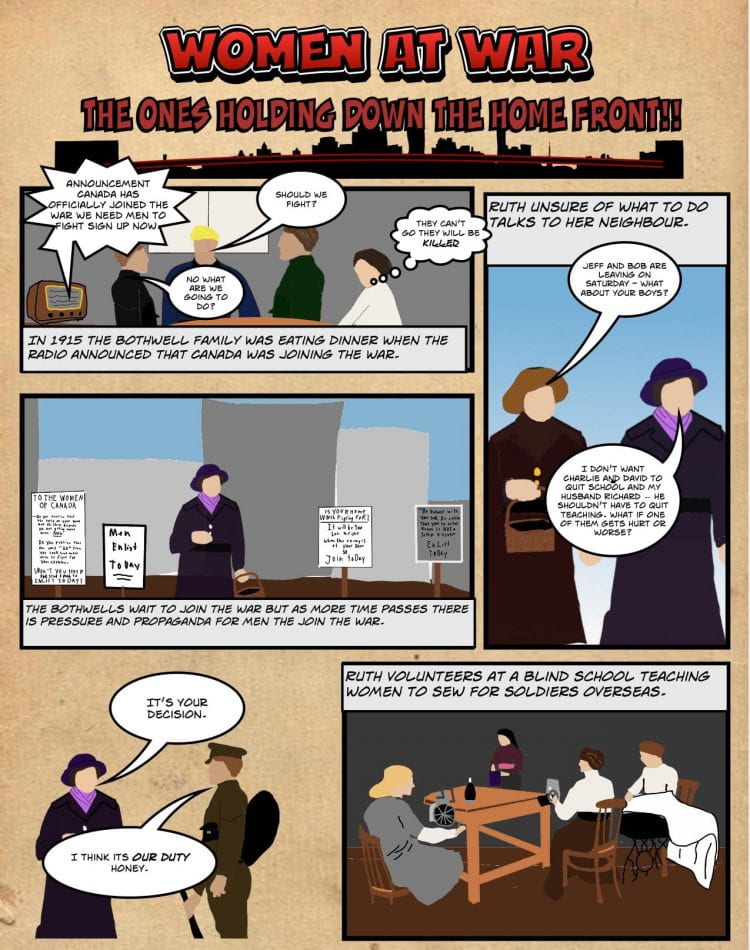
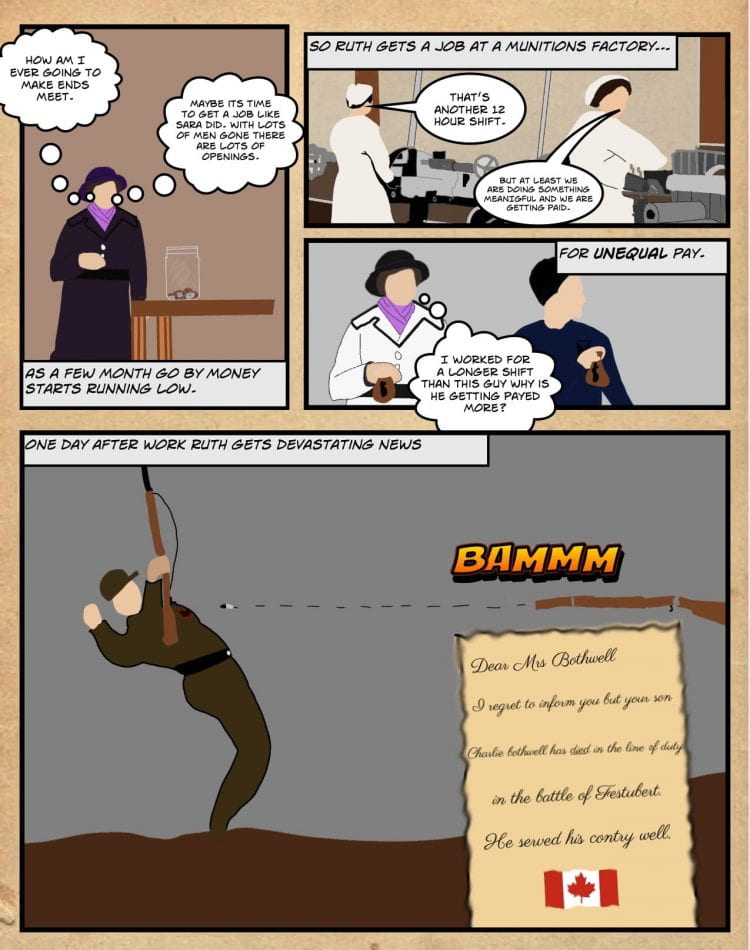
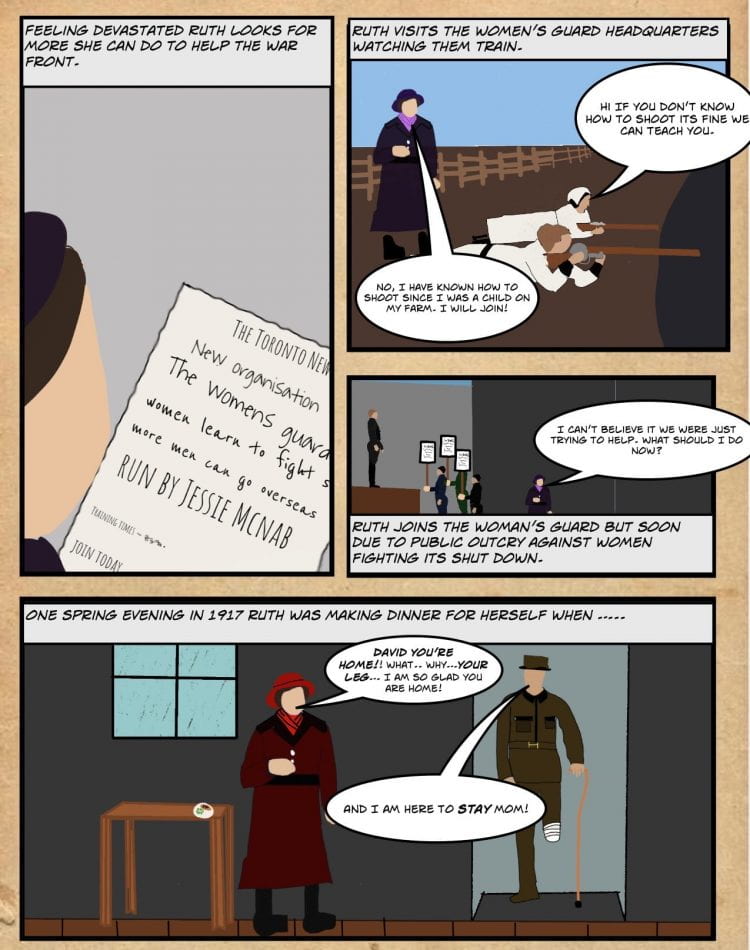
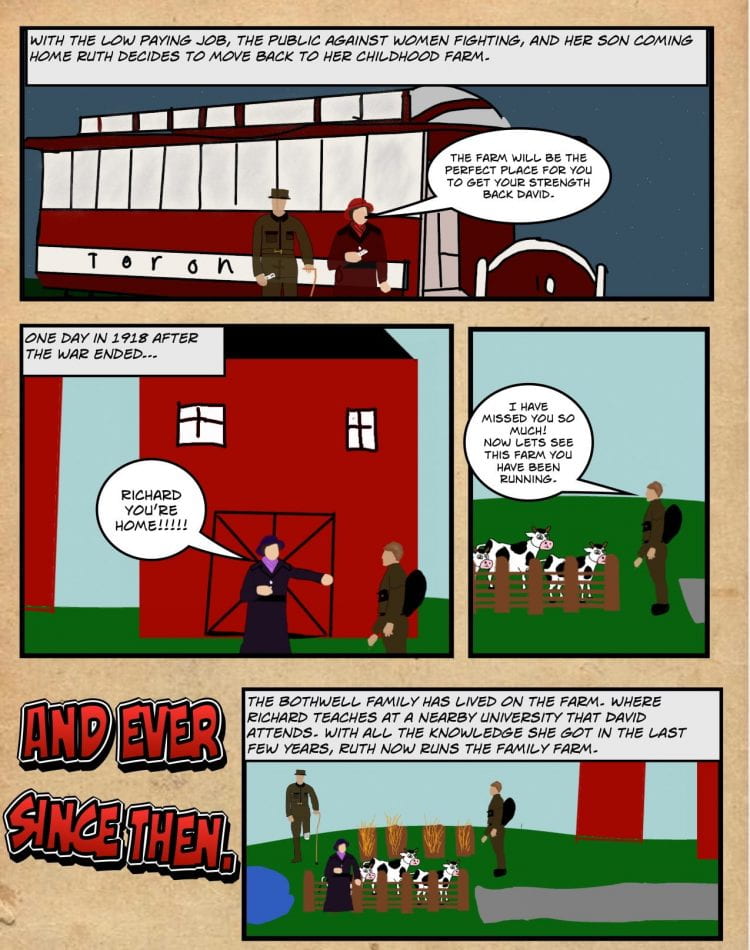
 For this topic I needed to research, use at least two sources, create a 5 W page, storyline and story board before I could even start the graphic novel. My topic was more challenging then I thought because I could not find exact dates and events of women here at Canada because most people were paying attention to the War and not as much as to what was happening here in Canada. Another challenge for me was creating the images for the graphic novel. Because there were not many photographs in my sources, there were not many to trace to then use for the graphic novel. I also found it very hard to actually to draw. However, when I look at my final product, I believe I was able to communicate what I wanted to say.
For this topic I needed to research, use at least two sources, create a 5 W page, storyline and story board before I could even start the graphic novel. My topic was more challenging then I thought because I could not find exact dates and events of women here at Canada because most people were paying attention to the War and not as much as to what was happening here in Canada. Another challenge for me was creating the images for the graphic novel. Because there were not many photographs in my sources, there were not many to trace to then use for the graphic novel. I also found it very hard to actually to draw. However, when I look at my final product, I believe I was able to communicate what I wanted to say. With a focus on the communicating core competency, I chose to represent my learning of habits 5 and 6 in a visual way. I decided to create a photo Collage of group projects. This visual display demonstrates my growth in collaboration skills. We have had a variety of projects that require working in a group such as DI, Revolutions on trial, metaphor machines. Seeing all these photos showcases all the skills I have to use when I work in a group.
With a focus on the communicating core competency, I chose to represent my learning of habits 5 and 6 in a visual way. I decided to create a photo Collage of group projects. This visual display demonstrates my growth in collaboration skills. We have had a variety of projects that require working in a group such as DI, Revolutions on trial, metaphor machines. Seeing all these photos showcases all the skills I have to use when I work in a group. connect to Habits 4 and 7 in a kinesthetic way. Since building relaxes me and allows me to show my creativity, I decided to make a fort. I like to be in comfortable places and forget the world around me. I also love being with my family/friends and decided that building with my friend Maya would be something we both enjoy and a way for me to recharge.
connect to Habits 4 and 7 in a kinesthetic way. Since building relaxes me and allows me to show my creativity, I decided to make a fort. I like to be in comfortable places and forget the world around me. I also love being with my family/friends and decided that building with my friend Maya would be something we both enjoy and a way for me to recharge.